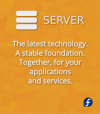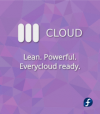(→Spins) |
(→Spins) |
||
| Line 121: | Line 121: | ||
=== Spins === | === Spins === | ||
There's a new spin in town for Fedora 23. Want a classic take on a modern desktop? If so, the '''Cinnamon spin''' may just be what you're hoping to find. | There's a new spin in town for Fedora 23. Want a classic take on a modern desktop? If so, the '''Cinnamon spin''' may just be what you're hoping to find. Cinnamon provides a "traditional" desktop environment similar to that of GNOME 2, but using the modern GNOME Shell from GNOME 3.x. Learn more at [http://cinnamon.linuxmint.com/ Cinnamon]. | ||
Sugar on a Stick is a stand-alone implementation of the desktop environment originally designed for the One Laptop per Child project. Fedora's SoaS spin has been updated to '''Sugar 0.106''', for better performance, updated activities, and a new "social help" feature for collaborative learning. | Sugar on a Stick is a stand-alone implementation of the desktop environment originally designed for the One Laptop per Child project. Fedora's SoaS spin has been updated to '''Sugar 0.106''', for better performance, updated activities, and a new "social help" feature for collaborative learning. | ||
Revision as of 19:41, 2 November 2015
Announcing Fedora 23
It's (approximately) Halloween, so you know what that means — new Fedora! The Fedora 23 release is here, and it's better than ever before. We're pleased to bring you the latest incarnations of the three main Fedora editions,Fedora Workstation, Fedora Cloud and Fedora Server, each built with love by the Fedora community to custom-fit your needs in different areas. Fedora 23 is also available in alternate desktop Spins, curated software Labs and in special images for the ARM. architecture.
If that's all you need to hear, download from https://getfedora.org/, or if you already use Fedora, follow the simple upgrade steps. Otherwise, read on for details.
A Brief Introduction to Fedora Editions
Fedora Workstation
 |
If you're a software developer, laptop or home user, hobbyist, enthusiast, or student, Fedora Workstation is perfect for you. Fedora Workstation includes the newest release of the GNOME desktop, which makes your everyday computing simple, polished, and pleasant. Experience the sleek interface and powerful tools for yourself — download Fedora Workstation now! |
Fedora Server
 |
Fedora Server makes service management simple with RoleKit, a programmatic interface for quick deployment, and Cockpit, a remote web GUI. Now in Fedora Server 23, you can manage Kubernetes clusters from the Cockpit Admin Console, or launch a FreeIPA domain controller from a kickstart file. Get Fedora Server this morning and have an identity management solution in place by lunchtime. |
Fedora Cloud
Spins, Labs, and ARM
| Fedora Spins are alternative desktops for Fedora that provide a different experience than the standard Fedora Workstation edition. For instance, the Fedora KDE and Fedora Xfce spins provide popular alternatives to GNOME for Fedora users who enjoy the KDE or Xfce experience. Get Fedora 23 Spins. | |
| Fedora Labs are curated collections of software maintained by members of the Fedora Community where you can find updated live media focused on Games, Design, Robotics, and more. These may be installed on their own or as add-ons to existing Fedora installations.Get Fedora 23 Labs. | |
| Fedora ARM project is an initiative to bring Fedora to this processor family. It provides the Fedora operating system tailored for running in on ARM-based systems, which was previously mixed into the Spins page. Get Fedora 23 Arm. |
Desktop Software Improvements
As with every Fedora release, almost every component has a new version, with improvements across the board. Of particular note:
Gnome 3.18
The Workstation release is shipped with Gnome 3.18 and the first relevant improvement for a user is due to the possibility of accessing the files stored in Google Drive via the Nautilus file manager. Just enable the GNOME Online Accounts (in initial setup or via the settings panel), and access will be granted — now Google Drive will appear just like a network share.
Boxes
Boxes is a simple, beautiful application for managing virtual machines — allowing you to run other operating systems under Fedora, or to develop against Fedora Cloud or Fedora Server from your Workstation. The new version has a much improved user interface, with a new list view with filtering.
LibreOffice 5
And, for everyone who writes papers, creates presentations, or deals with spreadsheets, Fedora 23 includes LibreOffice 5 which brings with it an increased accuracy in importing files from other office suites and over 25,000 bugfixes.
Improvements Across the Editions
Fedora-Wide Changes
Fedora 23 includes a number of changes that will improve all of the editions. For example, Fedora 23 makes use of compiler flags to improve security by "hardening" the binaries against memory corruption vulnerabilities, buffer overflows, and so on. This is a "behind the scenes" change that most users won't notice through normal use of a Fedora edition, but will help provide additional system security.
Likewise, Fedora 23 has disabled SSL3 and RC4 by default due to known vulnerabilities in the protocols. This means all applications that use GNUTLS and OpenSSL libraries have had the SSL3 protocol and RC4 cipher disabled.
Fedora 23 comes with the latest version of Mono 4. This means a big improvement because we were stuck with an ancient version of Mono (2.10) for too long. All packages within Fedora that are based on Mono have been adjusted and rebuilt, to target the 4.5 version of the .Net framework. Mono 4 does not support solutions targeting v1.0, v2.0 or v3.5 of .Net, but usually they can be easily upgraded to v4.5.
Fedora 23 also includes support for Unicode 8.0, which includes new emojis — including the all-important U1F32D. There are also improvements in sorting Unicode text and processing non-ASCII URLs.
Fedora Server
The Fedora Server release includes improvements for server role deployment and management.
The rolekit service now supports setting up three roles. In addition to the previously supported Domain Controller (powered by FreeIPA abd Database Server (powered by PostgreSQL) roles, Fedora Server 23 features a cache server for web applications (powered by memcached).
Rolekit can also now be used from the anaconda kickstart by passing the --deferred arguments to rolectl. For example: rolectl deploy domaincontroller --name=example.com --deferred will instruct the system to deploy the Domain Controller role on the next boot.
The Cockpit Admin Interface in Fedora Server has several big improvements as well.
- Support for SSH key authentication
- Support for configuring user accounts with their authorized keys.
- Basic cluster dashboard for driving Kubernetes on Fedora Server and Fedora Atomic Host.
- Set the timezone for your Fedora Server from the Cockpit User Interface (UI).
- Cockpit has also been made safe to use with multipath disks.
Fedora Workstation
While there's a lot going on under the hood, desktop users are also going to find Fedora 23 pretty exciting for all the obvious goodness coming to the desktop. The easiest way to experience the preview of these technologies is to download and try the Fedora 23 Workstation edition.
Naturally, GNOME is getting an upgrade, with Fedora 23 containing a preview of the upcoming GNOME 3.18 release, which is easier to use than ever. There are also many enhancements on the way, such as:
- Improvements to next-generation graphics stack Wayland, preparing it to be the default graphical server in a future release.
- Support for ambient backlight drivers, so brightness responds to the environment on laptops with the required hardware
- The Software application can now update system firmware
- Refreshed support for Google APIs to provide access to user data through GNOME apps (including Google Drive integration)
Users trying to get a little work done on Fedora will be happy to see LibreOffice 5 in Fedora 23. The new release includes a lot of new features and improvements:
- Style previews in the sidebar
- Microsoft Word-compatible text highlighting
- Built-in image crop
- UI for data bars in Calc
- Support for Time-Stamp Protocol in PDF export
- Support for Adobe Swatch Exchange color palettes
- Import of Apple Pages files
- Improved support for HiDPI screens
- Significantly improved support for MS Office formats
Fedora Cloud
Fedora 23 Cloud Base image includes many updates and enhancements to the underlying Fedora base packages. For example, Fedora 23 now has the latest Docker release, docker 1.8. We can now verify the publisher of an image before running. This gives the users the power to identify that the image publisher published has not been tampered with.
Stay tuned for news about Fedora Atomic Host in the not too distant future!
Other notable changes in Fedora
Spins
There's a new spin in town for Fedora 23. Want a classic take on a modern desktop? If so, the Cinnamon spin may just be what you're hoping to find. Cinnamon provides a "traditional" desktop environment similar to that of GNOME 2, but using the modern GNOME Shell from GNOME 3.x. Learn more at Cinnamon.
Sugar on a Stick is a stand-alone implementation of the desktop environment originally designed for the One Laptop per Child project. Fedora's SoaS spin has been updated to Sugar 0.106, for better performance, updated activities, and a new "social help" feature for collaborative learning.
Python3
Every software written in Python shipped by default on Fedora Workstation DVD and Fedora Cloud images is now running on Python3. Fedora Workstation doesn't even include Python2 in the default installation (it is still possible to install Python2 through dnf). Note that /usr/bin/python binary remains unchanged and still points to Python2.
Downloads, upgrades, documentation, and common bugs
You can start by downloading Fedora 23:
If you are upgrading from a previous release of Fedora, refer to:
Read the full release notes for Fedora 23, guides for several languages, and learn about known bugs and how to report new ones:
Fedora 23 common bugs are documented at:
This page includes information on several known non-blocker bugs in Fedora 23. Please be sure to read it before installing!
Contributing
It's finally here! We hope you're as excited as we are about Fedora 23 and look forward to exploring it yourself. Don't forget — Fedora never stands still we're always working towards a new and better release and sharing our work with the world. Want to be part of the fun? It's easy to get involved.
There are many ways to contribute to Fedora, even if it's just bug reporting. You can also help translate software and content, test and give feedback on software updates, write and edit documentation, design and do artwork, help with all sorts of promotional activities, and package free software for use by millions of Fedora users worldwide. To get started, visit http://join.fedoraproject.org today!




